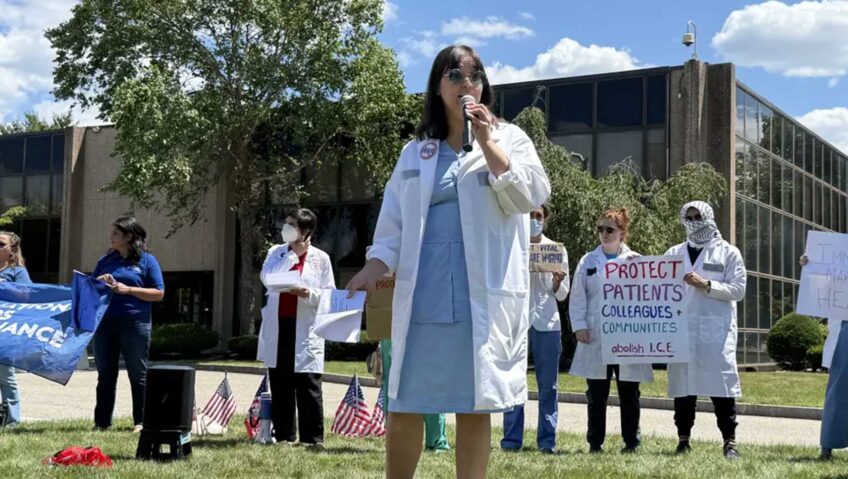

Redevelopment plans for the Whittier Street Apartments public housing development call for the current 200 affordable housing units to be replaced with 200 newly constructed affordable units, as well as an additional 353 units of mixed-use housing.
The Boston Housing Authority plans to revamp the current Whittier Street public housing development and the surrounding Roxbury neighborhood in a $339 million project that includes housing, commercial development, health and human services, public safety initiatives and job development.
The BHA has spent the last year working on the plan — including input from neighborhood residents — but now is looking for additional input before coming up with a final plan by October.
At the heart of the effort is the 61-year-old Whittier Street Apartments which, according to city officials, is overdue for being replaced. The city studied the development in 2012 and estimated rehabilitation costs at over $40 million, a number that pushed planners toward the target of tearing down the housing and building it anew.
Besides the need for new housing to replace the old public housing, the Whittier Street Apartments and a development project surrounding it ticked off all the boxes to qualify for a U.S. Department of Housing and Urban Development Choice Neighborhoods Grant, namely to re-develop distressed housing with affordable housing, but also to be part of a larger effort to revamp and economically boost the surrounding area.
Boston received a 2012 Choice Neighborhoods Planning Grant to develop what the city is calling the Whittier Neighborhood Transformation Plan. The final plan that will be developed by this fall will then be submitted to HUD for grant approval. The effort is a collaboration of the Boston Housing Authority, Preservation of Affordable Housing, Madison Park Development Corporation and the Whittier Tenant Task Force.
According to Kate Bennett, deputy administrator for planning and sustainability at the Boston Housing Authority, the Choice Neighborhoods grant — expected to be $30 million — is the critical seed money to get the entire project off the ground. But it also widens the scope of the work.
“Choice Neighborhoods really changes the game a bit in terms of expanding the impact under the grant beyond just housing revitalization into the people’s side and the neighborhood opportunities and services,” Bennett said. “We are not just taking down deteriorated public housing and rebuilding it.”
Choice Neighborhood money necessitates economic and community development in the area around the development of housing — without the added focus on the neighborhood and people, the HUD grant would not be approved.
“The focus on Whittier Street was really that we felt that it was a site that was in need of revitalization, but also had a lot of surrounding amenities and opportunities that would make for a successful implementation,” Bennett said.
The city defines the Whittier neighborhood as roughly one square mile, boarded by Tremont Street on the North end, flanked by Melnea Cass Boulevard, then outlined by Hampden Street into Blue Hill Avenue and stretching down past Dudley Square.
An estimated 9,300 residents live in the neighborhood in just under 4,000 households.
The neighborhood is made up of 59 percent black or African American residents and 34 percent Hispanic or Latino residents. The majority of the households are low-income: 75 percent receive housing or other public subsidies and 47 percent are below the federal poverty level (compared with 21 percent citywide). The unemployment rate is almost double the city’s rate at 19 percent compared to 10 percent citywide.
As is a focus of Choice Neighborhood grants, the city plans to tie in the new development with the education, civic and cultural institutions in the neighborhood, including Northeastern University, Roxbury Community College, Wentworth Institute, the Reggie Lewis Athletic Arena, Boston Police headquarters, the Boston Islamic Center, Hibernian Hall and the new Whittier Street Health Center.
In addition, the city has already begun work on over $130 million in investment in the commercial hub of Dudley Square and Melnea Cass Boulevard. Over $2.3 billion in private funding for infrastructure, new housing and retail are slated for the area over the next decade, according to city officials.
On the housing front, the plan calls for direct one-for-one replacement of the 200 affordable housing units currently available at Whittier Street Apartments.
According to Boston Housing Authority Administrator and Chief Executive Officer Bill McGonagle, the direct replacement of the affordable housing is the lynchpin of the project.
“That was a priority of ours as well as a priority of the Whittier Street residents. There will be no loss of affordable units,” McGonagle said. “We are trying to get a plan that has broad-based community support, that on the one hand ensures affordable housing for our existing Whittier Street residents, as well as providing housing for other folks in the city.”
All told, the Whittier project calls for the development of 553 new units of housing, as well as approximately 50,000 square feet of commercial and institutional space.
The 353 units built in addition to the 200 affordable units that will be built to replace the current housing at Whittier Street Apartments, will be a mix of moderate-income and market-rate housing.
All of the units will be dispersed throughout the redevelopment around the Whittier Street Apartments site. This includes both the original Whittier property, owned by the Boston Housing Authority, as well as adjacent publicly owned property — the Crescent Parcel at the intersection of Tremont Street and Melnea Cass Boulevard, owned by the Boston Redevelopment Authority — and property nearby in the neighborhood that is currently owned by Madison Park Development Corporation.
Most of the off-site development will be in close proximity to the original Whittier property, however, approximately 15 percent of the planned housing will be developed in nearby mixed-income, mixed-use properties.
Specifically, there will be 200 affordable housing units, 147 moderate income units and 206 market-rate units.
The plan also calls for at least 60 percent one- and two-bedroom units among the affordable housing units, in response to community needs found in the planning study. Across the entire redevelopment, including moderate-income and market-rate units, the goal is to build at least 80 percent one- and two-bedroom units.
Of the planned commercial and institutional space, about 10,000 square feet are targeted to be developed at the current Whittier Street Apartments site and another goal is to establish a restaurant or entertainment venue along Tremont Street.
John Barros, chief of economic development for the city, said the project is a very important one because of the addition of housing stock to the city and the plan to provide a boost to the local economy.
“This is a model project and we should be thinking more about the kinds of development that we could create near or using Boston Housing Authority properties,” Barros said. “This is good for the Dudley area. It is good for Ruggles. It is good for how we move forward. It presents a strategy that Boston will reflect on and we will probably use again and again.”
While some view the current Whittier Street Apartments as one of the better city-owned housing developments, McGonagle said the buildings have serious interior issues, including electrical.
Whittier Street was also chosen for development based on the requirements of the Choice Neighborhoods Grant.
For one, the $30 million grant of seed money for the project is enough to have an impact on the replacement of the 200 affordable housing units. Other city properties that could use work, such as the Mary Ellen McCormack development in South Boston, the Charlestown Bunker Hill development or the Bromley-Heath development in Jamaica Plain — which have 1,000 or more housing units — are too large to redevelop through a Choice Neighborhoods Grant, according to McGonagle.
Lastly, many other city-owned properties have gone through renovation in recent years.
“If you go down the pecking order, Whittier Street jumps out and it is kind of next in line for renovation,” he said. “It is kind of Whittier Streets’ turn.”
As part of the overall development project, the plan addresses what it calls “Neighborhood Goals” and “People Goals,” in addition to the housing.
The main focus on the neighborhood is to improve public safety and encourage more pedestrian traffic with transportation and streetscape developments.
For the residents of the neighborhood, the plan calls for income and asset-building support, establishing health-services programs, developing education partnerships and making better use of youth development programs, including career counseling, after-school and summer programs.
The Whittier Neighborhood Transformation Plan estimated price tag of $339 million includes $10.5 million for human services such as job development, health and wellness and education; $19.5 million for neighborhood services such as public safety initiatives and streetscape and connectivity improvements; and $309.4 million for housing of which residential development has the highest price tag at $265 million, with infrastructure development and non-residential development slated for $20 million each.
In addition to the federal seed money and backing from the city, the Whittier Choice project is support by The Boston Foundation, Northeastern University, Wentworth Institute of Technology, Roxbury Community College, Whittier Street Health Center, Dudley Street Neighborhood Initiative and The American City Coalition.






